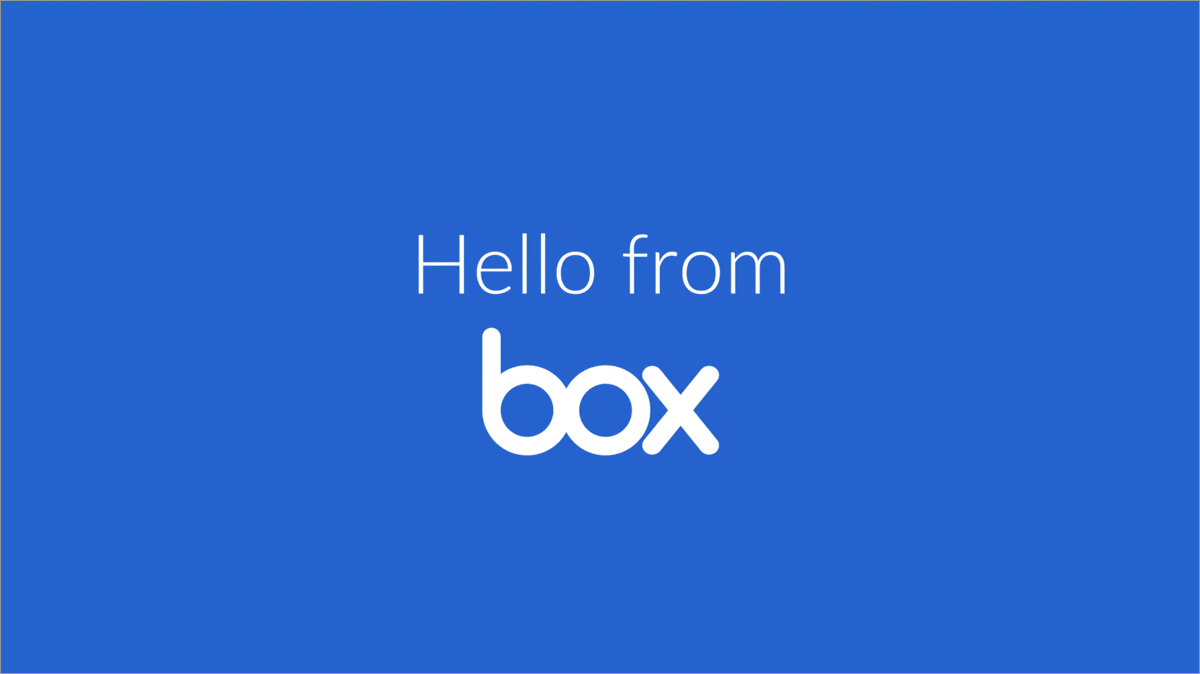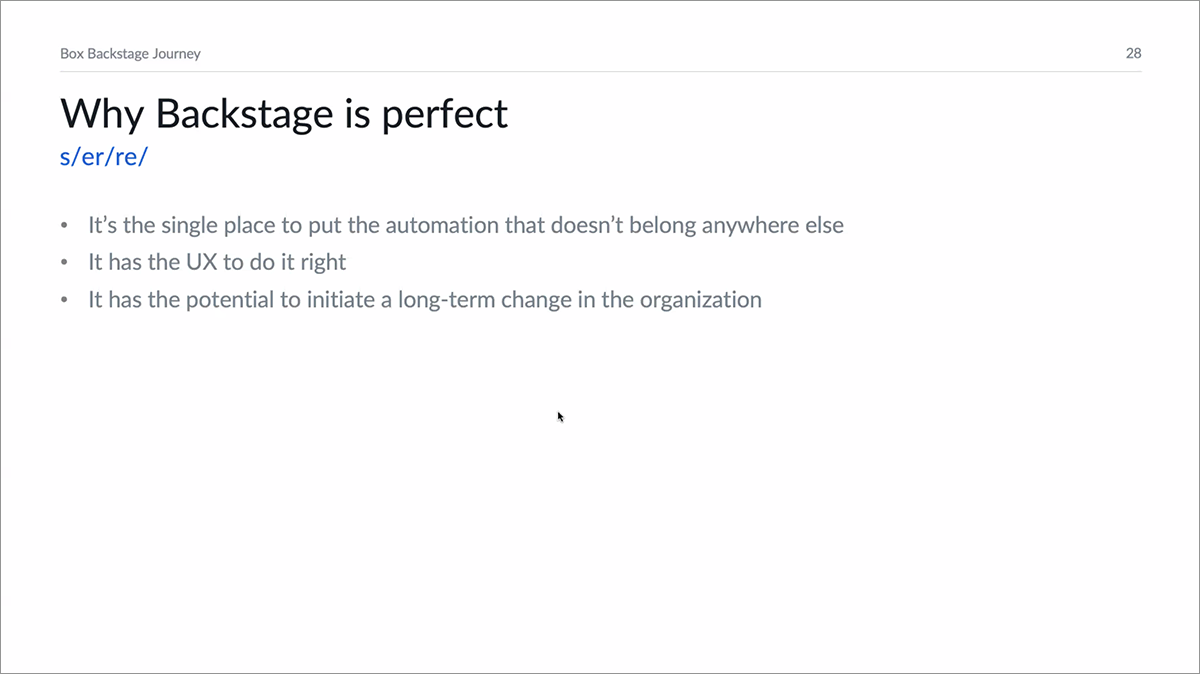Community Session: Box debuts their Backstage developer portal, plugin news, and more
- Author
- Suzanne Daniels, Spotify
- Published

Watch the Community Session videos below to see Box unveil their Backstage developer portal to the public for the first time, including a demo of their custom Prefect.io plugin. Plus, what’s coming next with the Backstage Kubernetes plugin, adoption and contribution tips, Q&A, and more. But first: Box says hello to the community.
Unboxing the Box DevPortal
Box DevOps engineer Jarek Łukow gave us an inside look at the company’s Backstage implementation. After the Box team incorporated their existing service catalog and grabbed a few open source plugins from the Plugin Marketplace, their Backstage MVP was off to a solid start.
Next, the team used Backstage Software Templates (aka the Scaffolder) to make it easier for their engineers to create new services: just click through a few form fields, and a “Hello World” skeleton project is automatically set up in a new repo with the first build already running. But the team wanted to go further, pushing automation and standardization beyond the CI pipeline.
“A higher-order pipeline”
Whenever a developer uses the Box DevPortal to create a service, they don’t just get a component built to Box’s engineering best practices. Each new component also enters an onboarding workflow that makes it easy to adopt other organizational standards, from policy compliance to budget reviews.
These higher-order pipelines automate practices that were previously considered “non-technical”, making the processes more accessible and more engineering-friendly. The workflows are also designed to be customizable, so that any team can add their own.
“It has the UX to do it right”

Along with being a single place for engineers to go, Box says Backstage “has the UX to do it right”. Other highlights from Box’s presentation:
- Ready-to-use plugins: As Box started adopting plugins built by the Backstage community, they happily discovered that because of their high quality, they could start using most of these open source plugins right away, making it unnecessary to create custom versions for themselves. (Yay, community!)
- Beyond the CI pipeline: In addition to using Backstage Software Templates for creating standardized components, the Box team also built standardization workflows for policy compliance, security approvals, API governance, access control, and everything else their developers need to onboard and manage a service — all integrated right inside Backstage.
- A central hub: By integrating different systems and departments scattered across their engineering org, the Box DevPortal streamlines processes that used to be handled by a mishmash of Slack messages, random video calls, piles of support tickets, and other engineering time sucks.
- Prefect.io plugin demo: Stay tuned till the end to see Box’s custom Prefect plugin in action, converting complex workflows into a simple UI — exactly the kind of developer-friendly experience Backstage was made for.
“This is awesome…now automate everything else”

Internal feedback at Box was positive. When their developer portal launched and the team shared these automation features with the wider engineering community at Box, Jarek says the response could be summed up as, “This is awesome. Now what I would like you to do is automate everything else.” It sounds like Box’s journey with Backstage has just begun.
Jarek covers a lot more in his presentation (custom widgets!), so make sure to watch the whole thing in the adopters session video below.
Watch the adopters session
Before Box took center stage, the Spotify team informed the community about plans for introducing paid plugins in 2022. Plus, Q&A with big questions, like “How will I know if Backstage will work at a large company like mine?”
- Spotify shares news from the future: In 2022, Spotify is going to start selling plugins for Backstage. This is in addition to the open source plugins that the team will continue to develop and contribute to the community. Over the years, Spotify has built tons of internal plugins and we continue to create brand-new ones. By introducing some of these plugins as commercial products, Spotify is doubling down on Backstage with a sustainable business model as the cornerstone to our long-term commitment to the project. Read more in the announcement or join the waitlist for the paid plugins alpha.
- Box says hello to the community: Using Backstage to build a developer portal that brings higher-order workflows to their engineering org — and makes the everyday experience of their developers easier.
- Q&A: How can you use the Backstage homepage to improve the customer journey and internal onboarding? Why should you build up your internal Backstage community with hackathons and meetups? And what kind of adoption has Backstage seen at large organizations, such as government agencies, financial institutions, and telcos (e.g. TELUS, Canada’s largest telecommunications company)? You’ll have to watch the video to find out.
Watch the contributors session
In the contributors track for this month’s community session, hear about upcoming deprecations, the fruits of Hacktoberfest, the future of both the Kubernetes plugin and the Tech Insights plugin, tips on contributing, and more. Highlights include:
- Maintainer update on ongoing deprecations: Out with the old, in with the new. Look for more deprecations coming your way as maintainers continue to stabilize core parts of the project, particularly in the frontend plugins (core-app-api, core-plugin-api, errors, config, etc.). So make sure to read those changelogs for smoother migrations!
- Contributor Spotlight: Hooray for Hacktoberfest! Our contributor of the month is Colton (@cmpadden), data engineer and web developer at Georgetown University. He got started with Backstage during Hacktoberfest, refactoring the Create App CLI (#7844) and improving support for TechDocs on GCS and S3 (#7554). But once he discovered how welcoming the community was, he just kept on contributing (#8096: Mmm…donuts). Thanks, Colton, and welcome to the Backstage community!
- Future contributions to the Kubernetes plugin: Spotify’s Warp Speed squad share their ideas on what to consider when contributing to the Backstage Kubernetes plugin going forward — including updates on the team’s recent work refactoring and simplifying duplicate code, upcoming changes to Kubernetes’ main API that will soon make it easier to show resource usage in Backstage (for example, CPU/memory usage per container), adding direct links to logs regardless of cloud provider, ideas for further customization returning objects, and more. Feedback, suggestions, and, of course, contributions are welcome!
- More advice on contributing to Backstage: Hear more thoughts on the best ways to work with the Backstage maintainers and core teams. Thinking about a big change? Raise an issue early on. Have a rough idea for something? Try writing a draft pull request sharing a little bit of code and then get feedback on whether to continue further.
- Updates on the Tech Insights plugin: Jussi Hallila from Roadie.io shares the latest on stage 2 of the Tech Insights plugin — including progress on scorecards, fact retrievers, and building an MVP for displaying a “time-to-10th pull request” metric. As Jussi says, the more contributions, the better!
Want even more demos, updates, and discussion? Join us next month!